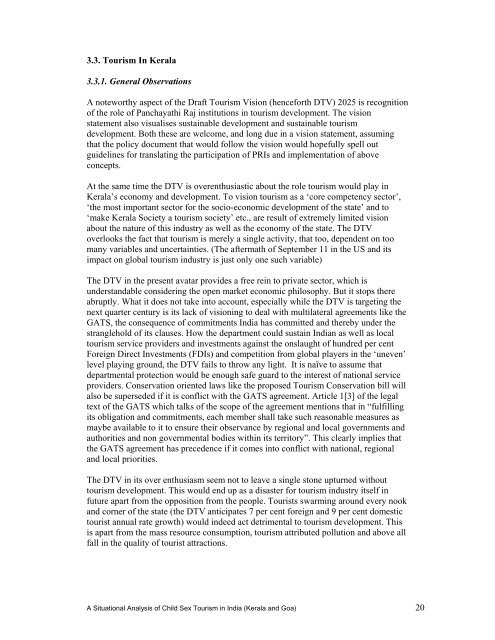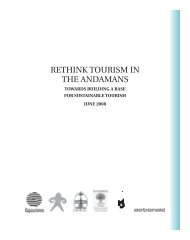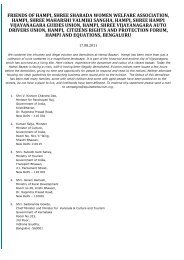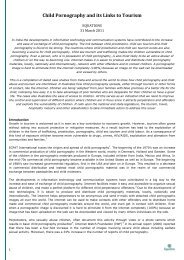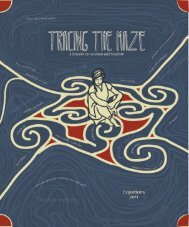A Situational Analysis of Child Sex Tourism- 30 December 2003 ...
A Situational Analysis of Child Sex Tourism- 30 December 2003 ...
A Situational Analysis of Child Sex Tourism- 30 December 2003 ...
Create successful ePaper yourself
Turn your PDF publications into a flip-book with our unique Google optimized e-Paper software.
3.3. <strong>Tourism</strong> In Kerala3.3.1. General ObservationsA noteworthy aspect <strong>of</strong> the Draft <strong>Tourism</strong> Vision (henceforth DTV) 2025 is recognition<strong>of</strong> the role <strong>of</strong> Panchayathi Raj institutions in tourism development. The visionstatement also visualises sustainable development and sustainable tourismdevelopment. Both these are welcome, and long due in a vision statement, assumingthat the policy document that would follow the vision would hopefully spell outguidelines for translating the participation <strong>of</strong> PRIs and implementation <strong>of</strong> aboveconcepts.At the same time the DTV is overenthusiastic about the role tourism would play inKerala’s economy and development. To vision tourism as a ‘core competency sector’,‘the most important sector for the socio-economic development <strong>of</strong> the state’ and to‘make Kerala Society a tourism society’ etc., are result <strong>of</strong> extremely limited visionabout the nature <strong>of</strong> this industry as well as the economy <strong>of</strong> the state. The DTVoverlooks the fact that tourism is merely a single activity, that too, dependent on toomany variables and uncertainties. (The aftermath <strong>of</strong> September 11 in the US and itsimpact on global tourism industry is just only one such variable)The DTV in the present avatar provides a free rein to private sector, which isunderstandable considering the open market economic philosophy. But it stops thereabruptly. What it does not take into account, especially while the DTV is targeting thenext quarter century is its lack <strong>of</strong> visioning to deal with multilateral agreements like theGATS, the consequence <strong>of</strong> commitments India has committed and thereby under thestranglehold <strong>of</strong> its clauses. How the department could sustain Indian as well as localtourism service providers and investments against the onslaught <strong>of</strong> hundred per centForeign Direct Investments (FDIs) and competition from global players in the ‘uneven’level playing ground, the DTV fails to throw any light. It is naïve to assume thatdepartmental protection would be enough safe guard to the interest <strong>of</strong> national serviceproviders. Conservation oriented laws like the proposed <strong>Tourism</strong> Conservation bill willalso be superseded if it is conflict with the GATS agreement. Article 1[3] <strong>of</strong> the legaltext <strong>of</strong> the GATS which talks <strong>of</strong> the scope <strong>of</strong> the agreement mentions that in “fulfillingits obligation and commitments, each member shall take such reasonable measures asmaybe available to it to ensure their observance by regional and local governments andauthorities and non governmental bodies within its territory”. This clearly implies thatthe GATS agreement has precedence if it comes into conflict with national, regionaland local priorities.The DTV in its over enthusiasm seem not to leave a single stone upturned withouttourism development. This would end up as a disaster for tourism industry itself infuture apart from the opposition from the people. Tourists swarming around every nookand corner <strong>of</strong> the state (the DTV anticipates 7 per cent foreign and 9 per cent domestictourist annual rate growth) would indeed act detrimental to tourism development. Thisis apart from the mass resource consumption, tourism attributed pollution and above allfall in the quality <strong>of</strong> tourist attractions.A <strong>Situational</strong> <strong>Analysis</strong> <strong>of</strong> <strong>Child</strong> <strong>Sex</strong> <strong>Tourism</strong> in India (Kerala and Goa) 20


